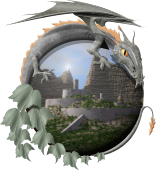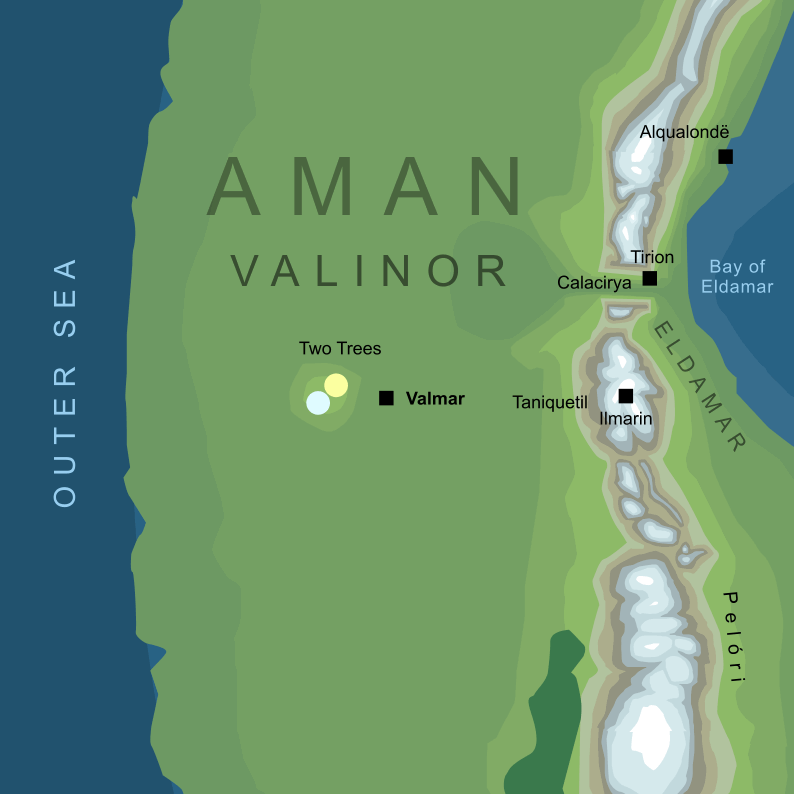- Cities and buildings
- Fields, plains and deserts
- Forests
- Hills and mountains
- Islands and promontories
- Lands, realms and regions
- Rivers and lakes
- Seas and oceans


 |
||||||
|


Which personality type are you?
Take the Free mydiscprofile Personality Test to discover your core personality and your ideal job.   Which personality type are you? |
|
Dates
Location
Race
Division
Pronunciation
va'lmarr ('rr' emphasises that the final r sound should be distinctly pronounced)
Meaning
Literally 'home of the Powers'
Other names
Indexes: About this entry:
|
ValmarThe city of the Valar
The city of Valmar in Valinor (conjectural)
The city of Valmar in Valinor (conjectural)
The shining city of the Valar stood on the plains of Valinor westward of the Mountain Wall of the Pelóri. The city was raised by the Valar after they departed from Middle-earth in the deep past of Arda, to settle in the far West of the World. Valmar (also often known as Valimar)1 had a name meaning 'home of the Powers', and was the place where the Valar and the Maiar gathered for council or festival. The city shone in gleaming light, with silver domes rising above streets of gold, and the whole surrounded by a wall with golden gates.2 It contained green lawns and playing fountains, and the air was filled with the sound of pealing bells. At times, at least in the earlier days of Valinor, the Vala Nessa would dance on the lawns of the city, and the Maia Melian would sing in Valmar, and at those times the bells of the city fell silent. Beyond the walls of Valmar to the west was a great Green Mound, and it was here that Yavanna caused the Two Trees of Valinor to grow and shed their Light across the land. Here too, was the Ring of Doom, the Máhanaxar where the Valar would gather in council to debate great matters or come to weighty judgements. For the most part the Valar seem not to have dwelt in their own city, instead each preferring halls of their own across Valinor, but the city was frequented by the Maiar, and also by the Eldar after that people travelled to Aman. Valmar in the History of AmanThe city of Valmar itself played little direct part in history, but the Ring of Doom before its gates was the site of many momentous events. The earliest of these to be recorded was brought about by the return of Oromë from Middle-earth, carrying news that he had discovered the newly-awakened Elves in Middle-earth. At the Ring of Doom, Manwë pronounced that the Valar should again take thought for distant Middle-earth, and protect the Elves from the Dark Lord Melkor. This proclamation led to the Battle of the Powers that saw Melkor defeated and imprisoned, as well as the Great Journey in which many of the Eldar travelled across the Sea to Valinor. Melkor was held imprisoned by the Valar for three ages, and when those three ages had passed, the old Dark Lord was brought to Valmar were he submitted to the authority of Manwë. After this time he was permitted to go freely about the land, but he began to spread rumours and lies that sowed conflict among the Elves. This led in the end to Fëanor threatening his half-brother Fingolfin with a sword. The two were summoned to the Ring of Doom at Valmar, and Fëanor was exiled for twelve years. Melkor, whose lies had now been exposed, went to Fëanor and sought to turn him further against the Valar, but instead news was sent to Valmar carrying warnings of the Dark Lord's presence, forcing him to flee from Valinor for a time. Determined to heal the rift among the Eldar, the Valar held a great feast of reconciliation on Taniquetil. At this time, then, while the halls of Valmar were empty and quiet, a deep darkness suddenly descended on the city. This was the darkness of Ungoliant, an ancient being of spider shape, who had allied herself with Morgoth. The great spider now sucked the life from the Two Trees on the Green Mound westward of Valmar. The entirety of Valinor was plunged into darkness, as Morgoth and Ungoliant made their escape, shrouded in darkness, out of Aman and into Middle-earth. With the Two Trees now dark and dying, the Valar used the last of their Light to create the Sun and the Moon and set them into the sky. Melkor, now hiding in his fortress of Angband in the far North of Middle-earth, attacked the new Moon, and the Valar responded by setting a greater guard on their land. On the plains eastward of Valmar, a vast camp was created, filling the land with watchers as far as the pass of the Calacirya in the Mountains of Defence. After the Darkening of Valinor, Valmar played little part in the history of the outer world. When the spirit of Lúthien departed from Middle-earth and came to the Halls of Mandos, she was given the choice to dwell in the city, but she rejected this choice so that she could return to life with Beren. When more than five centuries had passed since the Darkening, Eärendil the Mariner came to the shores of Aman, and was brought to Valmar. There he stood before the Valar and pleaded for them to aid Elves and Men in their desperate Wars against Morgoth (the later name of Melkor, who had destroyed the Two Trees long beforehand). The Valar agreed, and so set into motion the events that would defeat the first Dark Lord and bring the First Age to an end. After the War of Wrath and the defeat of Morgoth, Valmar is not directly mentioned again. We do have an account of a later council of the Valar at which the Istari or Wizards, including the being later known as Gandalf, were selected to be sent to Middle-earth. The location of this council is not described, but if we presume that it was held at the Ring of Doom, then the Order of Wizards came into being before the gates of Valmar. This is the last reference (however indirect) that we have to the city, but doubtless it remained, and still remains, in the Blessed Realm beyond the Great Sea. Notes
See also...Aman, Corollairë, Coron Oiolairë, Ezellohar, Fëanor, Golden Tree, Green Mound, Lords of the West, Máhanaxar, Nienna, Powers of Arda, Ring of Doom, Salmar, Timeless Halls, Ulmo, [See the full list...] Indexes: About this entry:
For acknowledgements and references, see the Disclaimer & Bibliography page. Original content © copyright Mark Fisher 1998, 2001, 2013-2014, 2022. All rights reserved. For conditions of reuse, see the Site FAQ. Website services kindly sponsored by Axiom Discovery aptitude and skill testing.Personality is one part of understanding a candidate's suitability for a role, but aptitude can also be crucial. |